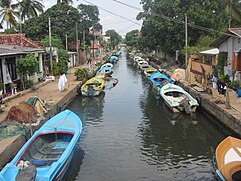Negombo
| Negombo | ||
|---|---|---|
| Negombo, Dutch Canal | ||
|
|
||
| State : |
|
|
| Province : | Western province | |
| District : | Gampaha | |
| Residents: | 122,000 (2003) | |
Negombo ( Sinhala මීගමුව [ ˈmiːgamuə ]) is a city on the west coast of Sri Lanka about 40 km north of the capital Colombo . The city is located in Sri Lanka's Western Province on the road and rail link from Colombo along the coast to the north. Negombo has about 122,000 inhabitants (as of 2003) and is one of the most important fishing ports on the west coast. Although the plays fisheries that are still traditionally some with Oruwas ( outrigger canoes is done), continues to be a significant role; north of the old city area, however, an extensive agglomeration with hotels, restaurants and other facilities of the tourism industry has developed.
After the capture of Colombo by Portugal in 1505, Negombo was one of the first areas to be taken over by the colonizers. The attempts at Christianization could therefore also be particularly successful here. To this day, a predominant part of the population of Negombo is Catholic . The conquest by the Netherlands in 1644 and Great Britain in 1796 left fewer traces. Only a Dutch fort and an approx. 120 km long canal built by the Dutch from Colombo via Negombo to Puttalam have survived . He served mainly for the transport of cinnamon , the then main export product of the colony .
The proximity to Bandaranaike Airport in Katunayake, which is approx. 20 km away, was decisive for the early boom in tourism . By the end of 2004, however, the cities on the southwest and south coast of Sri Lanka far surpassed Negombo in terms of its tourist importance.
Unlike other places on the Sri Lankan coast, Negombo was hardly affected by the tsunami caused by the seaquake off Sumatra on December 26, 2004. There were no fatalities, but fishing huts and hotels built directly on the beach were damaged.

